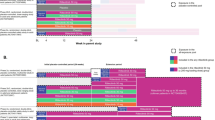Abstract
Introduction/Purpose: Cryptophycins are a family of antitubulin antitumor agents. A synthetic cryptophycin derivative (LY355703, CRYPTO 52) is in early clinical evaluation. The effect of infusion time on the antitumor activity of four cryptophycins was assessed in rats bearing the 13762 mammary carcinoma and combination treatment regimens were assessed in nude mice bearing human tumor xenografts. Methods: The cryptophycins were prepared in 2% PEG300/8% cremophor/90% normal saline and delivered by jugular vein catheter on days 7, 9 and 11 post tumor implant to 13762 tumor-bearing rats. The cryptophycins prepared in the same formulation were administered by intravenous bolus injection on an alternate day schedule for five doses to human tumor xenograft bearing nude mice. Results: An infusion time of 2 h in the rats increased the tumor growth delay produced by CRYPTO 52 and CRYPTO 55, while increasing the infusion time to 6 h continued to increase the tumor growth delay for CRYPTO 292 and CRYPTO 296. Administering CRYPTO 292 at a higher dose two times was more effective than administering it at a lower dose three times. The tumor growth delays produced by the cryptophycins in the rat 13762 mammary carcinoma were greater than those with cisplatin, doxorubicin, 5-fluorouracil and 5 × 3 Gray and comparable with cyclophosphamide and gemcitabine. Combination studies were carried out in human tumor xenografts including the MX-1 breast carcinoma, the Calu-6 non-small cell lung carcinoma, the H82 small cell lung carcinoma and the SW-2 small cell lung carcinoma. CRYPTO 52 and CRYPTO 55 combined with doxorubicin, paclitaxel and 5-fluorouracil to form highly effective regimens against the human MX-1 breast carcinoma. CRYPTO 52 and CRYPTO 55 were also highly effective against the three lung carcinoma xenografts when combined with the antitumor platinum complexes, cisplatin, carboplatin or oxaliplatin. Conclusions: Cryptophycins represent a promising new class of antitumor agents that may be optimally administered by intravenous infusion and in combination with doxorubicin, paclitaxel and 5-fluorouracil.
Similar content being viewed by others
Author information
Authors and Affiliations
Additional information
Received: 18 November 1999 / Accepted: 16 March 2000
Rights and permissions
About this article
Cite this article
Menon, K., Alvarez, E., Forler, P. et al. Antitumor activity of cryptophycins: effect of infusion time and combination studies. Cancer Chemother Pharmacol 46, 142–149 (2000). https://doi.org/10.1007/s002800000135
Issue Date:
DOI: https://doi.org/10.1007/s002800000135




